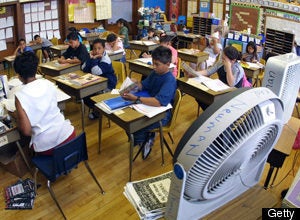
Last week, Chicago Public Schools officials unveiled a new plan for admitting students to CPS's magnet and selective enrollment programs. In the days ahead, a lot of ink will be spilled and a lot of voices will be heard debating the merits of the plan, because this plan will determine which kids get access to some of Chicago's top-performing academic programs.
Many Chicago parents go to great lengths to get their kids into the city's magnet and selective enrollment schools, because kids in those programs have generally performed at a higher level than their counterparts in the neighborhood schools. Indeed, a lot of Chicago parents (understandably) can't fathom sending their kids to their own neighborhood schools. Too many parents, however, also have no real choice in the matter. Chicago's magnet and selective enrollment programs have openings for just a small fraction of CPS's student population.
In addition to producing solid academic performers, the magnet and selective enrollment programs also provide some of the only diverse classrooms in our city. This fact can be traced back to a desegregation lawsuit filed nearly three decades ago.
In 1980, the federal government sued the Chicago Board of Education, claiming that the city ran a segregated public school system in violation of both the U.S. Constitution and the Civil Rights Act of 1964. To resolve that lawsuit, the Board of Education agreed to operate under a detailed court order designed to address the federal government's concerns and to help desegregate -- "to the extent practicable" -- Chicago's public school system. Though there were magnet schools in Chicago before the desegregation suit was filed, the Board's ongoing compliance with the court order resulted in a significant expansion of Chicago's magnet and selective enrollment programs.
Under the terms of the court order, CPS was permitted to consider a student's race as a factor in determining whether to admit that student to one of those programs. Two months ago, a federal judge vacated that long-standing order, effectively ending CPS's ability to use race or ethnicity as a factor in admissions.
Instead of using an individual student's race as a factor, CPS will now consider socio-economic data about the census tract in which that student lives. CPS CEO Ron Huberman believes the new plan "will maintain or grow the level of diversity that we have in our system."
That's a good sound bite, but Huberman knows there is very little racial or economic diversity in our public schools. There is also very little Huberman and his team can do about that. Chicago remains one of the most segregated big cities in the nation, and the city's public school system mirrors that segregation.
Let's look at some numbers. There are currently about 417,000 students enrolled in CPS programs. CPS classifies nearly 85% of those kids as coming from low-income families. Black and Latino students make up 86% of the CPS population; white students fill just 9% of the classroom desks. (In contrast, information from the last U.S. Census suggests that white students fill roughly 45% of the spots in the city's private schools.)
These numbers -- coupled with Chicago's de facto segregated neighborhoods -- make it nearly impossible for Huberman and his colleagues to produce diverse CPS classrooms on a grand scale. The recently vacated court order had at least ensured that some meaningful level of diversity would exist in the city's small collection of magnet and selective enrollment schools. The Chicago Sun-Times accurately described these programs as "an island of racially integrated schools in a sea of segregated ones."
During the next few weeks, CPS officials will likely discuss the new admissions plan with interested Chicago parents and members of the press. A lot of folks -- both inside and outside CPS -- will sing the praises of racial and socio-economic diversity, and that's all well and good. Remember, however, that while the island is drawing public attention, the sea continues to pound.
As you follow stories about the new plan, ask yourself the following questions. Would CPS have taken steps to create this island of racial or socio-economic diversity but for a federal lawsuit filed in 1980? Would CPS need to concern itself with these issues today if its schools had been providing equal opportunities to all kids in all neighborhoods over the years? Don't forget that back in 1966, when Dr. King attempted to march through a number of Chicago neighborhoods, he met with greater resistance here than he did when he marched through many cities in the Deep South. (Oh, to have been a fly on the wall when Mayor Richard J. Daley was discussing Dr. King's Chicago marches with the then 24-year-old Richard M. Daley.)
Let's hope the new CPS admissions plan does not re-segregate successful schools. But let's also keep our focus on the much bigger issue: How can parents, teachers and administrators improve the many under-performing neighborhood schools that are home to tens of thousands of low-income kids in Chicago's still-segregated neighborhoods?
